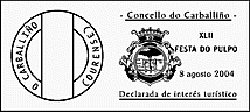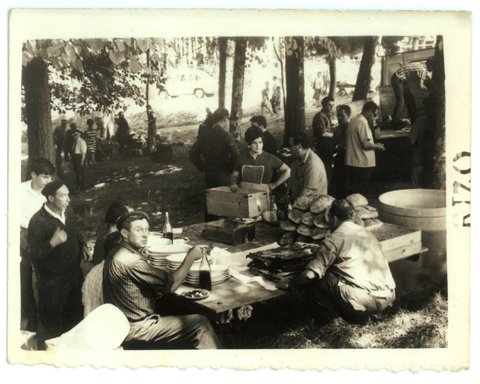
A FEST BETWEEN FRIENDS :
From an occasional meeting between a group of friends 51 years ago emerged what is today one of the largest gastronomic concentrations in Galicia.
ORIGIN, ANTIQUITY AND TRADITIONAL
On the second Sunday of August 2012, La Festa do Pulpo de O Carballiño celebrated its 50th Anniversary. Fifty uninterrupted years of history that may seem insignificant when compared to more than three centuries since the introduction of this marine product in the interior lands of Galicia, but which have proved more than enough to have achieved the highest gastronomic manifestation of Galicia. Qualification that we will endorse with a copy of numerous newspaper articles of recent years, which define it. Even if we stick to the number of visitors who come to this celebration every year, it would not be an exaggeration to place it among the first in Spain.
It is therefore a contemporary pilgrimage, which retains, however, all the ingredients of the old Galician pilgrimages, as reflected in some opinions of published experts, both by the Galician press and by the national and international press. Its success is, without a doubt, part of its connection with one of the most exclusive and ancient gastronomic manifestations of Galicia, the tasting of “Pulpo à Feira”, being the town of Santa María de Arcos, adjacent to O Carballiño and to whose town hall it belongs, its cradle, or rather, that of the “pulpeiras” and “pulpeiros”, authentic craftsmen of its preparation and guarantors by family and secular tradition of all its elaboration secrets.
“The party is celebrated on the second Sunday of August in the Municipal Park of the town and enjoys the privilege of being considered since 1969 Festival of Tourist Interest.”
“Enjoys the privilege of being considered since 2012″ Festival of National Tourist Interest ”
The origin of the party has a lot to do with this rich and ancient “pulpeira” tradition of the Carballinesa region, called “Orcellón”, and with the initiative of a group of neighbors who decide to pay tribute to this exquisite delicacy by creating institutionalizing a pilgrimage in which the true protagonist was the octopus. For this they had the appeal of this gastronomic dish, with all the “pulpeiras” of Arcos and what is not less important, with the appropriate natural framework, the Municipal Park of O Carballiño, created in 1927 and that, with an extension of thirty-two hectares of woodland of the most diverse species – oaks, camellias, lime trees, birches, cedars, eucalyptus, pines, etc …, with four natural sources, an ethnographic area that offers a whole, a School of Fishing, a Mill that is an ethnographic museum, a campsite, and the most important river in the region, the Arenteiro, which offers unlimited possibilities for the development of the party.
How this product of the Galician estuaries became the most popular and characteristic dish of this town and interior regions, and even of Galicia, deserves a brief historical reference, although before it is necessary to retake the thread of the origin of the party and highlight that the first edition of the “Festa do Pulpo” took place in September coinciding with the celebration of the patron saint festivities of the Carballinesa town. The successive ones, until today, were held in the middle of summer, every second Sunday of August, in order to guarantee the best weather and the greatest attendance of visitors.
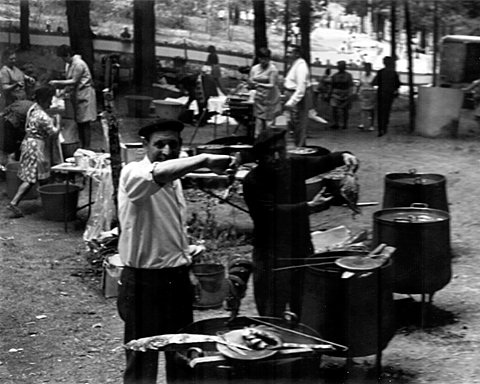
In its first editions in the sixties, there were many Carballineses who approached the municipal park to attend the pilgrimage, but the boom that would reach the party a few years later, in the seventies, with the mass influx of people from all over Galicia, from other places in Spain and even abroad, to which the presence of Galicians worldwide contributed greatly, the institutional promotion of the party and especially the declaration of the “Festa do Pulpo ”As a“ Tourist Interest ”party, which occurred in 1972.- (BOE Nº65 of March 16, 1972). Resolution of the General Directorate for Tourism Promotion by which the denomination of “Tourist Interest Festival” is granted. Madrid, February 4, 1972.
The traditional roots of the “Fiesta do Pulpo”, part of a historical past described in another section, which relates to the pulpeiras with fairs throughout Galicia and with the Galician tradition of Galicia.
The traditional roots of the “Festa do Pulpo”, part of a historical past described in another section, which relates to the pulpeiras with the fairs throughout Galicia and with the Galician tradition of Galicia. In this sense, the “Festa do Pulpo” of O Carballiño has managed to perfectly combine the most genuine tradition with the demands of each era; That is why, in just fifty years of history, this pilgrimage has become as essential as any other tradition in this field.
The "Festa do Pulpo" is held invariably, from its first editions, on the second Sunday of August of each year.
CULTURAL VALUE, MEANING AND SCOPE AS A TOURIST ATTRACTIVE.
Part of the cultural value that the “Festa do Pulpo” entails has been included in the previous chapter, when the anthropological importance of this pilgrimage has been highlighted. It is directly connected with the traditions emanating from the craftsmanship of the pulperos and other trades that, such as carpenters, brassworkers, iron and copper smelters or sharpeners, have been directly linked to the historical development of the pulperos. In addition, the octopus as a gastronomic product is related to other products that accompany it and among which we must mention the artisanal bread, specifically from Cea, traditionally made, with country wheat and wood oven, and Ribeiro wine, from the region of the same name, in whose highest part, in the mountain, O Carballiño is located.
In the “Festa do Pulpo” you can see some of these cultural connotations we are talking about related to popular gastronomy. Thus, in the case of pulperas, you can observe the complete process of preparation, cooking and preparation of the octopus to be cooked in copper boilers, let it stand and until it is cut into small slices and seasoned with coarse salt, oil of Olive and pepper, served on a wooden plate. This ritual, whose top secret lies in cooking, is followed by all the pulperas. Obviously, in the case of other craft trades, such as those already mentioned, you can not observe the process of manufacturing the products, but their commercialization, placing bakers, donuts, fruit bowls, etc …, by groups, representing guilds of great tradition in Galicia, typical of fairs and pilgrimages since the Middle Ages.
In recent years, a lot of artisans come to the site of this pilgrimage: potters, baskets, ropes, etc …, to sell their products, which adds a new cultural incentive to the party.
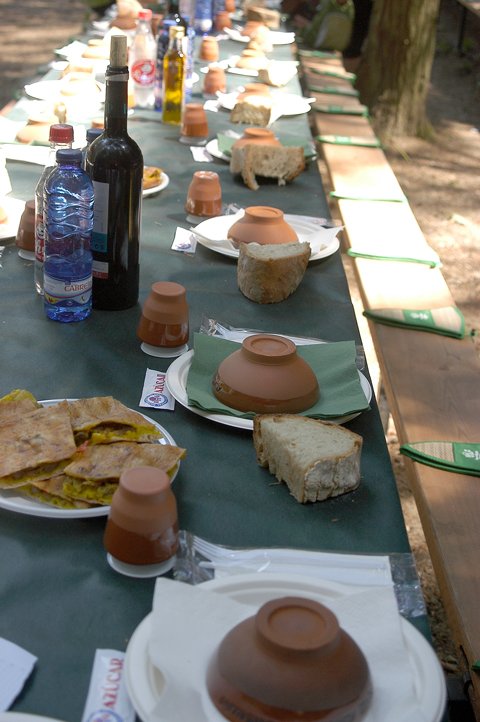
But if we are to highlight the cultural value of the “Festa do Pulpo”, we have to refer especially to the musical and folkloric aspects. In this edition, different groups of bagpipes come to each edition that, from all over Galicia, encourage the pilgrimage by interpreting their repertoires of popular Galician themes. These groups of bagpipes, formed by at least four members: two drummers and two pipers travel from the early hours of the morning to the municipal park site, entertaining the party in every corner. They are joined by groups that dance “muiñeiras”, Galician jotas or traditional polcas. In this sense, the participation of the numerous visitors of the “Festa do Pulpo” is high. There are even groups that sing, also spontaneously, popular Galician songs. This occurs among friends or families who gather to eat and live the pilgrimage.
In addition to the bagpipes groups, folk dance groups attend, offering traditional Galician dances in an auditorium in the same area of the municipal park. This is, perhaps, one of the most outstanding cultural elements of the pilgrimage, as a festival of traditional Galician dances is held, either in pairs, or in groups, which takes place in the morning and mid-afternoon. During the festival, visitors can observe both the evolution of typical Galician costumes, dressed by folk groups, and the different types of folk dances of the folkloric folkloric repertoire of Galicia.
From these cultural values that are deduced from the “Festa do Pulpo”, a complex meaning is derived that sums up the ancient history of Galician customs, whether gastronomic or otherwise, and that enhance the sense of the collectivity of ancestral cultures , participating and sharing all commercials, when meeting such a large number of product sales positions.
The meaning of the whole set could be summarized, then, as a current experience of the traditional fairs and pilgrimages of Galicia, in which the most playful aspect prevails: gastronomy, songs, dances; with the most commercial: sale of products of the rich Galician crafts.
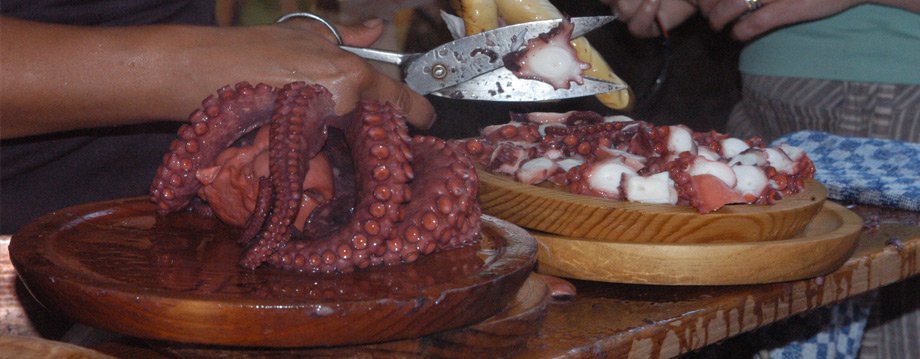
From both connotations, cultural values and meaning, the scope of the “Festa do Pulpo” can be seen as a tourist attraction. We will highlight, in the first place, the possibility of tasting all the typical products of Galician popular cuisine (“octopus feira”, Cea bread, empanadas of the most diverse species: meat, “xoubas”, or anchovies, eels, of bonito, chicken, etc …, roasted sardines, cooked meat or meat or caldeiro, donuts and gingerbreads, fruits from the Galician country, white and red Ribeiro wines, white and herb spirits, spirits) and a long etcetera of products that make up the popular Galician gastronomy and that in this pilgrimage are consumed by tons. Thus, the approximately fifty pulperas cook and prepare more than twenty-five thousand kilos of octopus; the various pieces of bread, empanadas, donut bouquets and kilos of peaches from the country. Thousands of liters of Ribeiro wine that are marketed and several hundred bottles of spirits and spirits must also be counted for thousands.
But, in addition to the gastronomic appeal, it is worth highlighting the scope of the cultural value offered by the pilgrimage, being able to live and observe, as noted above, the most varied and traditional folklore of Galicia, with all the richness of typical costumes and dances and musical pieces from the various areas of Galicia, both coastal and inland. It is even noteworthy the experience of popular songs spontaneously intoned by groups of friends and family in each place of the municipal park of O Carballiño.
Finally, the scope as a tourist attraction of the “Festa do Pulpo” is given by the natural framework that serves as the setting for this pilgrimage. This is the most extensive and well-kept municipal park in Galicia, which offers all the possibilities of recreation to fully enjoy the party without feeling the burdens of such a massive pilgrimage. To the characteristics of the same, already indicated in the previous chapter, it should be added that it is surrounded by a very careful residential area, in which we can contemplate beautiful examples of Galician architecture, whose basic pillars are granite, wrought iron balconies and the galleries, simulating the “pazos”, stately homes of the 17th and 19th centuries. On one side of the park is the main of the spas of O Carballiño, a stately construction of the nineteenth century, or more specifically of 1900, surrounded by leafy trees and gardens, which thousands of “agüistas” from all over Galicia come every summer and from the rest of Spain, to highlight and cure their ailments. On the opposite side of the part is the fish farm of O Carballiño, a nursery that repopulates every year of trout and fish many of the Galician rivers.
But this chapter would remain unfinished, referring to the scope of the party as a tourist attraction, but we would echo the “familiarity” with which all visitors are received, starting with the respect that all of them are professed in an eminently summer village and tourist, used to receive thousands of visitors every year. In addition, the “Festa do Pulpo” is possibly the only Galician pilgrimage that offers visitors the possibility of previously acquiring a card to go to the site installed by the City Council and taste all the products served in comfort; or, go to any of the food sales facilities, to taste their products there; or buy them and sit and taste them in any corner of the park. And all this, with a guarantee of quality and price controls, establishing a maximum price for each of the products, which are listed on panels installed throughout the park for visitor information.
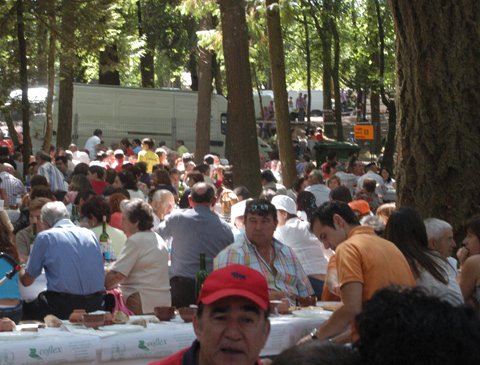
DATE OF CELEBRATION AND DESCRIPTION OF THE ACTS COMPOSING THE PARTY.
The “Festa do Pulpo” is invariably celebrated, since its first editions, on the second Sunday of August of each year. This date coincides with the tourist peak of Galicia and O Carballiño, which, with its two hot springs spas, attracts thousands of visitors every summer, most of which remain in the town for a period of not less than fifteen days.
This date also coincides with the greater presence of emigrants from O Carballiño and other Galician towns, who travel from their places of residence, both in Europe and in America, to spend their holidays on their land. This means that they can be accompanied by friends from these countries, which usually occurs with residents in Switzerland, France and Germany, mainly, and even in some Latin American countries, such as Argentina, Venezuela, Mexico, Panama and Cuba who are being dedicated editions of the “Festa do Pulpo” of recent years.
In the days before the party different events and activities related to the party are celebrated, highlighting the contest of clubs that bring together hundreds of young people who make a t-shirt contest that provide great animation and color to it.
The “Festa do Pulpo” is a rural gastronomic pilgrimage, so it takes place in the municipal park of O Carballiño, the events begin in the morning, with the parades and parades of the pipers and folk groups that depart from the City Hall of O Carballiño towards the fairgrounds. The activity in the park begins at ten in the morning, with the arrival of visitors and pilgrims. Previously, from dawn, pulpeiras, sellers of food or handicraft products, taverns, finalize the preparations to meet the demand of the several thousand visitors who come to the site and who do it massively around noon. Many of these visitors, especially those from the towns near O Carballiño, go with empanadas and other products, acquiring only the octopus on the premises.
The groups of bagpipes constantly tour the fairgrounds, satisfying the demand for interpretations requested by the pilgrims throughout the park.
From noon, the authorities and other guests are received at the official site, by local authorities, at an official reception at the town hall.
At twelve o’clock in the morning and later in its second part at approximately five o’clock in the afternoon, the folk festival of traditional Galician dances begins, with the performance of folk groups and the contest of jacks and dolls for couples and groups. This demonstration of Galician folklore lasts until eight in the afternoon.
The activity in the municipal park concludes around ten at night, when the pilgrims leave the municipal park.









